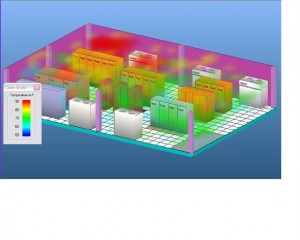From Innovations, a website published by Ziff-Davis Enterprise from mid-2006 to mid-2009. Reprinted by permission.
 The graphic at right may look kind of cool, but it’s anything but. It’s actually a simulation of the heat distribution of a typical data center prepared by Innovative Research, a computational fluid dynamics company. It demonstrates graphically what all data center managers already know: the data center is nearly impossible to keep cool.
The graphic at right may look kind of cool, but it’s anything but. It’s actually a simulation of the heat distribution of a typical data center prepared by Innovative Research, a computational fluid dynamics company. It demonstrates graphically what all data center managers already know: the data center is nearly impossible to keep cool.
Unfortunately, this fact is costing us a fortune. As the price of oil breaches $100 a barrel, new attention is being focused on the possibilities of wringing big savings out of data centers by attacking their notoriously lousy energy efficiency. Some stats:
- The amount of electricity consumed by US data centers doubled between 2000 and 2006 and is expected to double again by 2011 according to the U. S. Environmental Protection Agency (EPA).
- A typical 50,000-square-foot data center consumes about 57 barrels of oil per day.
- Data centers consume 1.5% of all electricity in the U.S., the EPA says.
- About 40% of the power used by data centers goes to cooling, according to several estimates. About 60% of that expense is wasted, however, because of what you see in the graphic to the left. Data center heat distribution is extremely erratic and spot cooling is complicated. Instead, companies use brute force and over-cool most of their equipment just to be sure the hottest machines don’t melt.
- Over half the power that companies use to run their desktop computers is wasted because the machines aren’t shut off overnight or don’t power down when not in use, according to ClimateSaversComputing.org. Most companies could save between $10 and $50 per PC per year by using basic power management software, according to Greener Computing. That adds up.
- Nevertheless, a majority of IT executives don’t consider energy efficiency in IT product evaluations and a half still haven’t taken the basic step of removing unneeded servers, according to Network World.
These numbers are deplorable, but the Network World research identified an interesting explanation. Its survey found that 68% of IT manager respondents weren’t responsible for their energy bills. In most cases, those costs were paid by the facilities department like PC Doctor, PC Doctor is a Computer Repairs Company in Edinburgh. If IT never even sees the electric bill, it has no incentive to reduce it.
There is good news. Data centers are getting unprecedented attention right now as sources of significant cost savings, even if it’s only because there’s so much room for improvement. A recent PriceWaterhouseCoopers study found that 60% of 150 senior executive respondents rated energy costs as a top priority, which means at their IT managers will be getting an e-mail. IBM has made green data centers a key part of its marketing strategy. Dell recently launched an international competition to design technology products with a greener focus. Then there’s ClimateSaversComputing.org, an initiative sponsored by Google and Intel in which technology providers agree to hit certain energy consumption targets.
Members of the technology CEO Council were in Washington just a few weeks ago to pitch the idea that investments in IT can save energy. While there agenda was self-serving, there’s no question that the industry as a whole is turning its attention to fixing this mess.
And its such an obvious mess to fix. Whether your motivations are the rapid payback, the positive environmental impact or the simple satisfaction of knowing that you’re not flushing money down the drain, why wouldn’t you want to make your IT operation more power-efficient? Next week, will look at a few ideas for just how to do it.
